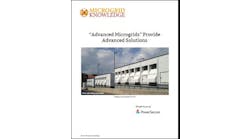It’s difficult to secure financing for energy retrofits in small commercial buildings, which make up 90 percent of commercial properties in the U.S. Kat Friedrich, of the Yale Center for Business and the Environment, explores the problem.
Small commercial energy efficiency retrofits are often at the bottom of building owners’ priority lists. According to “Financing Small Commercial Building Energy Performance Upgrades: Challenges and Opportunities,” a report published in January by National Institute of Building Sciences (NIBS), a complex knot of challenges is preventing building owners from both seeking financing and accessing it. The authors recommend that government organizations step in with policies and programs designed to cut the knot and set financing in motion.
These interlaced challenges inhibit financing for a huge number of buildings. Close to 94 percent of United States commercial properties fall into this category. Almost nine out of ten commercial properties in the nation measure under 25,000 square feet.
Skepticism Restricts Demand and Supply
What is holding financing back?
“We saw two main groups of barriers – one being on the supply side and one being on the demand side,” said Ryan Colker, director of consultative counsel and presidential advisor at NIBS’s Council on Finance, Insurance and Real Estate (CFIRE).
On the demand side, building owners are highly skeptical energy retrofits will deliver reliable returns on investments. They rarely have trained staff who can oversee building performance and provide them with accurate information about energy efficiency. Building owners also tend to focus on urgent repairs rather than planning other retrofits.
Supply-side concerns also inhibit financing. Commercial building structures – and ownership and leasing arrangements – vary considerably, making financing difficult. Owners often have less-than-ideal credit histories. And the hybrid nature of energy efficiency loans, which combine the traits of construction loans and permanent loans, complicates lending.
Building owners are “certainly a bit leery about going through a retrofit project with potentially, in their minds, uncertain results,” Colker said. “I think some of it is just a lack of experience. In general, they’re probably just a bit skeptical as to the long-term value of investing upfront.”
A specific segment of property owners’ costs is tied up in salaries – and energy tends to be a lower-cost and therefore lower-priority line item, Colker said.
Building owners “tend to focus on the day-to-day challenges rather than the long-term challenges,” Colker said.
The report does not discuss the need for public outreach extensively. However, misunderstandings about the value of energy efficiency could be addressed by expanding utility communication efforts on a large scale.
“Being able to pull together data to actually demonstrate the achievements and results would be helpful,” Colker said.
Turnkey Solutions Could Build Opportunities
Most tools and technologies for commercial energy efficiency are geared toward large buildings, Colker said. This means that there is a market opportunity now for innovative companies to step in and develop straightforward solutions for smaller commercial buildings.
“There’s certainly a huge opportunity,” Colker said. “If companies could come up with turnkey solutions, that would be incredibly valuable. We could think about a turnkey solution where the financing, the technologies, and the practices were all rolled into one offering, a one-stop shop for a small building owner.”
To reach investors, Colker recommends encouraging project standardization. Bundling projects would be attractive to institutional investors.
Financing Programs Could Reach Building Owners
The report recommends that the federal government build upon and link existing programs to assist small businesses.
“There are already some good programs out of the Small Business Administration (SBA) to provide loans to small businesses,” Colker said. “Largely, to date, those funds have not focused on building retrofits. Linking SBA programs with technical assistance available at the Department of Energy would be helpful.”
Property-assessed clean energy (PACE) and on-bill financing are two existing options the report recommends. PACE loans are repaid similarly to property tax assessments and are considered higher-priority than mortgages. On-bill financing programs fund retrofits via utility bills over a specified number of years.
Revolving loans and loan guarantees are options states and municipalities can explore. When establishing revolving loan funds, states set aside a specific pool of money that can be reused for subsequent loans as the initial loans are repaid. Loan guarantees may involve states and municipalities assuming debts if building owners default.
Equipment loans, capital leases, contractor-based financing, managed energy service agreements, and real estate investment trusts (REITs) may also help the market grow. In managed energy service agreements, customers pay for energy as a service over time at agreed-upon rates. REITs are companies that own or finance income-producing real estate and can provide energy-related financing. ‘
Disclaimer: James Finlay, one of the coauthors of this report, is affiliated with the Clean Energy Finance Forum.
This article was originally published by the Clean Energy Finance Forum, which is sponsored by the Yale Center for Business and the Environment. The author, Kat Friedrich, serves as the forum’s editor.






